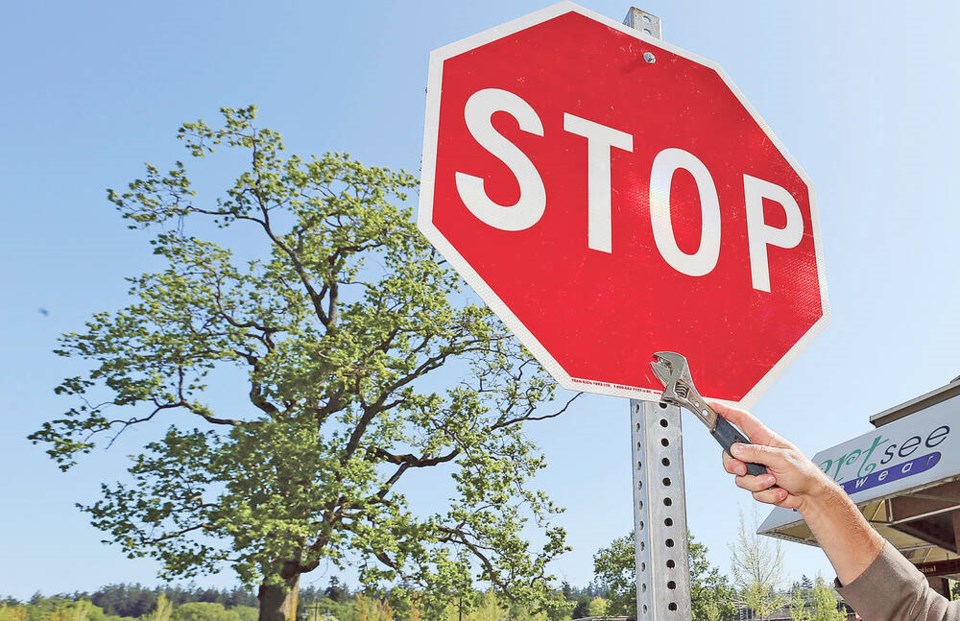There’s been some buzz on social media in Esquimalt the past 10 days. It’s not the usual stuff about lost dogs, the newest offerings at the farmers market or the latest weird beeping tones coming from those ultra secret warehouses inside CFB Esquimalt.
(By the way, if you are a lost dog or cat for that matter, in Esquimalt you can pretty much relax. Know that there is a search and find network like none other springing into action to help reunite you with your human.)
The buzz, though, is about the four-way stop sign at Lyall and Macaulay streets. I’m sure most people in our region don’t even know where that is. But the people who live in that neighborhood certainly do and the number of drivers ignoring those four red octagons is driving them nuts.
It’s probably the most basic rule in driving. When you see a stop sign — you stop.
Our motor vehicle act doesn’t give you any discretion on this one. Stop means: “a complete cessation of movement.”
It doesn’t mean: “slow down enough to get your seatbelt on” or; “just take it down a bit to switch from texting to Spotify.”
In the case of a four-way intersection it certainly doesn’t mean: “There’s no one else here — so cruise on through.”
Four-way stop intersections happen because there’s a decent amount of traffic flowing on two intersecting streets but not enough to warrant a signal light. They are also necessary when visibility is restricted on one, or both, of the streets and we want approaching vehicles to stop first, so they have a really good look at each other.
In the case of Lyall and Macaulay we want them there because these streets are right in front of a busy elementary school.
Four-way stop rules are maybe not the simplest ones in the driving manual and judging by the complaints in Esquimalt, a few people need some review.
The basic rule is that if you’re the first one in — you’re the first one out.
If two cars arrive at approximately the same time, you yield to the car on your right.
Approximately is the important word. It means that you don’t measure your approach in millimetres trying to figure if you can beat the other car.
Arriving at almost the same time is, by definition — approximate — and you should yield to the car on the right — even if in your mind you were first by a hair’s breadth.
If two cars stop at the four way facing each other and one is wanting to make a left turn, then the left turn car must yield to a car intending to go straight through. The law requires left-turning vehicles at an intersection to yield to other vehicles that are close enough to be a hazard.
This also means that if you are turning left after your stop, you should yield to a car that is turning right on the other side of the intersection.
If both vehicles intend to turn left or both vehicles intend to turn right, they should, in theory, have enough room depending on the size of the intersection to turn at the same time.
Any confusion about all of this is easily eliminated by making eye contact with the other driver and then using hand signals, not including the middle finger, to let the other car know what you’re doing.
Be patient. If there’s any doubt, hand signal and let the other person go first. It costs two to three seconds at most.
Both the military police and VicPD have been out recently looking for stop sign violators in this area, which also borders military housing and a repair depot for the Esquimalt base.
Police are often called to enforce against driving scofflaws in neighbourhoods and where do a good number of these scofflaws come from? Yep…the neighbourhood.
To be fair, in this case, there is a large amount of base traffic moving back and forth from the dockyard to the repair depot and to nearby Workpoint, so I’ll be interested to see what the cops observe.
The larger point here, though, is that even if there isn’t a lot of traffic around at certain times in a residential neighbourhood, people live there. They’re watching how you drive. When you blow through stop signs or speed through school and playground zones you’re thumbing your nose at them.
You’re telling them by your driving behaviour that their safety and peace of mind don’t matter.
Whether you live in the same area or not, you wouldn’t want it happening on your street. Neither do the people near Lyall and Macaulay.



